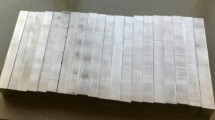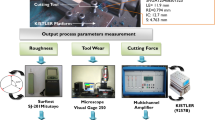Abstract
In this study, 25 (five factors at two-level factorial design) design of experiment was applied to investigate a set of optimal machining parameters to achieve a minimum surface roughness value for Abies nordmanniana. Wood specimens were prepared using different values of spindle speed, feed rate, depth of cut, tool radius, and cutting directions. Average surface roughness \( \left( {R_{z} } \right) \) values were applied using a stylus. The objectives were to: (1) obtain the effective variables of wood surface roughness; (2) analyze which of these factors had an impact on variability in the CNC machining process; (3) evaluate the optimal cutting values within the range of different cutting levels of machining parameters. The results indicate that the design of experiment (DOE) based on the desirability function approach determined the optimal machining parameters successfully, leading to minimum R a compared to the observed value. Minimum surface roughness values of tangential and radial cutting directions were 3.58 and 3.21 µm, respectively.








Similar content being viewed by others
References
Albert A (2009) Understanding CNC routers. FPInnovations-Forintek Division Press, Canada
Antony J (2014) Design of experiments for engineers and scientists. Elsevier, London
Asiltürk I, Neşeli S, İnce MA (2016) Optimization of parameters affecting surface roughness of Co28CrMo medical material during CNC lathe machining by using the Taguchi and RSM methods. Measurement 78:120–128
Bhalamurugan R, Prabhu S (2015) Performance characteristic analysis of automated robot spray painting using Taguchi method and Gray relational analysis. Arab J Sci Eng 40:1657–1667
Bingöl D, Saraydin D, Özbay DŞ (2015) Full factorial design approach to adsorption onto Hydrogels. Arab J Sci Eng 40:109–116
Coelho CL, Carvalho LMH, Martins JM, Costa CAV, Masson D, Meausooner PJ (2008) Method for evaluating the influence of wood machining conditions on the objective characterization and subjective perception of a finished surface. Wood Sci Technol 42:181–195
Cool J, Hernandez RE (2011) Improving the sanding process of black spruce wood for surface quality and water-based coating adhesion. For Prod J 61:372–380
Davim JP, Clemente VC, Silva S (2009) Surface roughness aspects in milling MDF (medium density fiberboard). Int J Adv Manuf Technol 40:49–55
Deus PRD, Alves MCS, Vieira FHA (2015) The quality of MDF workpieces machined in CNC milling machine in cutting speeds, feed rate, and depth of cut. Meccanica 50(12):2899–2906
Gaitonde VN, Karnik SR, Davim JP (2008) Taguchi multi-performance characteristics optimization in drilling of medium density fibreboard (MDF) to minimize delamination using utility concept. J Mater Process Tech 196:73–78
Gurau L, Mansfield-Williams H, Irle M (2005) Processing roughness of sanded wood surfaces. Holz Roh Werkst 63:43–52
Hiziroglu S (1996) Surface roughness analysis of wood composites: a stylus method. For Prod J 46(7–8):67–72
ISO 4287 (1997) Geometrical product specifications (GPS) surface texture: profile method-terms, definitions, and surface texture profile method terms, definitions and surface texture parameters. International Organization for Standardization, Geneva
Jacob S, Banerjee R (2016) Modeling and optimization of anaerobic codigestion of potato waste and equatic weed by response surface methodology and artificial neural network coupled genetic algorithm. Biores Technol 214:386–395
Kopac J, Sali S (2003) Wood: an important material in manufacturing technology. J Mater Process Tech 133:134–142
Krimpenis AA, Fountas NA, Ntalianis I, Vaxevanidis NM (2014) CNC micro milling properties and optimization using genetic algorithm. Int J Adv Manuf Technol 70:157–171
Lu C (2008) Study on prediction of surface quality in machining process. J Manuf Process Tech 205:439–450
Montgomery DC (1997) Design and analysis of experiment. Wiley, New York, pp 218–224
Myers RH, Montgomery DC, Anderson-Cook CM (2009) Process and product optimization using designed experiments. Wiley, New Jersey, pp 36–44
Norazmein AR, Safian S, Sudin I (2012) Mathematical modeling of cutting force in milling of medium density fiberboard using response surface method. Adv Mater Res 445:51–55
Ozdemir T, Hiziroglu S, Kocapınar M (2015) Adhesion strength of cellulosic varnish coated wood species as function of their surface roughness. Adv Mater Sci Eng 2015:1–5
Ohuchi T, Murase Y (2006) Milling of wood and wood -based materials with a computerized numerically controlled router. V: development of adaptive control grooving system corresponding to progression of tool wear. J Wood Sci 52(5):395–400
Palanikumar K, Muthukrishnan N, Hariprasad KS (2008) Surface roughness parameters optimization in machining A356/SiC/20p metal matrix composites by PCD tool using response surface methodology and desirability function. Mach Sci Technol 12:529–545
Prakash S, Palanikumar K (2010) Modeling for prediction of surface roughness in drilling MDF panels using response surface methodology. J Compos Mater 45:1639–1646
Raja SB, Baskar N (2011) Particle swarm optimization technique for determining optimal machining parameters of different work piece materials in turning operation. Int J Adv Manuf Technol 54:445–463
Safuoglu SD (2015) Determination of optimal machining parameters of massive wooden edge-glued panels made of European larch (Larix Decidua Mill) using Taguchi method. BioResources 10(4):7772–7781
Saleem MM, Somá A (2015) Design of experiments based factorial design and response surface methodology for MEMS optimization. Microsyst Technol 21(1):263–276
Sandak J, Tanaka C (2003) Evaluation of surface smoothness by laser displacement sensor-1: effect of wood species. J Wood Sci 49(4):305–311
Sütçü A (2013) Investigation of parameters affecting surface roughness in CNC routing operation on wooden EGP. BioResources 8(1):795–805
Sutcu A, Karagöz Ü (2012) Effect of machining parameters on surface quality after face milling of MDF. Wood Res 57(2):231–240
Tan PL, Sharif S, Sudin I (2012) Roughness models for sanded wood surfaces. Wood Sci Technol 46:129–142
Taylor JB, Carrano AL, Lemaster RL (1999) Quantification of process parameters in a wood sanding operation. For Prod J 49:41–46
Wilkowski J, Czarniak P, Grześkiewicz M (2011) Machinability evaluation of thermally modified wood using the Taguchi technique. In: COST Action FP0904 workshop echano-chemical transformations of wood during thermo-hydro-mechanical (THM) processing, pp 109–111
Zhong ZW, Hiziroglu S, Chan CTM (2013) Measurement of the surface roughness of wood based materials used in furniture manufacture. Measurement 46(4):1482–1487
Author information
Authors and Affiliations
Corresponding author
Additional information
Project funding: This research was performed in the laboratuary of Istanbul University, Faculty of Forestry where the authors are employed at present. There were no other funding resources.
The online version is available at http://www.springerlink.com
Corresponding editor: Yu Lei.
Rights and permissions
About this article
Cite this article
Hazir, E., Erdinler, E.S. & Koc, K.H. Optimization of CNC cutting parameters using design of experiment (DOE) and desirability function. J. For. Res. 29, 1423–1434 (2018). https://doi.org/10.1007/s11676-017-0555-8
Received:
Accepted:
Published:
Issue Date:
DOI: https://doi.org/10.1007/s11676-017-0555-8




